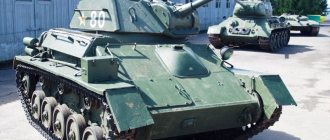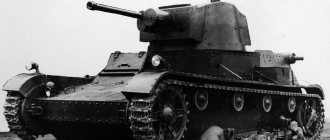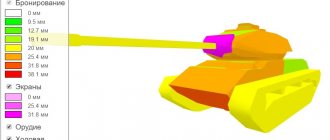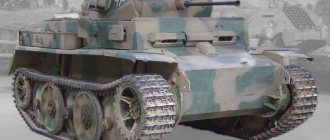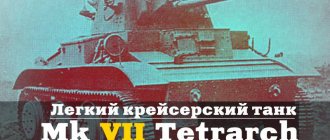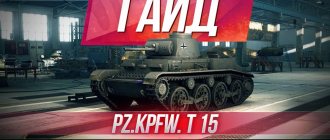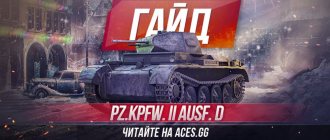The hastily developed T-60 light tank clearly lacked firepower and protection, and the designers realized this. But it was no longer possible to return to the production of the rather advanced T-50 light tank. A new armored vehicle had to be created on the basis of the T-60. Immediately after its launch into production, Nikolai Astrov began work on further improving the machine.
The T-70 prototype was assembled at the beginning of 1942, and at the end of February it went for testing and officially entered service in March. In the same year, mass production of the “seventieth” began, quickly displacing its predecessor from the production lines.
Description of design
The T-70 inherited its layout from its predecessor. The transmission was located in the front part of the welded hull, in the stern there were fuel tanks and a cooling system, the fighting compartment was combined with the engine compartment. But the power plant itself has changed - instead of one six-cylinder car engine, two began to be installed. Accordingly, doubled - up to 140 hp. – power has increased. The engines were started by electric starters connected in parallel; a pre-heater boiler was available.
The T-70 four-speed gearbox was manufactured based on components from the ZiS-5 truck gearbox. The chassis has changed somewhat due to an increase in the overall length - the road wheels have become five instead of four. The suspension remains torsion bar, without shock absorbers.
Two tankers sat behind each other, to the left of the engines. The commander remained overloaded with responsibilities - he also performed the tasks of a gunner and loader. On the T-70, unlike its predecessor, an intercom for crew members became standard equipment for linear light tanks. Only command vehicles were still equipped with radio stations.
To ensure the operation of the radios, more powerful generators were installed on the commander's T-70s.
The thickness of the upper frontal sheet of the T-70 was increased to 35 mm (it had an angle of inclination of 62⁰), the lower (with a smaller angle of inclination) - up to 45 mm. Such armor could protect against 37 mm and 50 mm shells. The thickness of the vertical sides is 15 mm, sufficient for protection from bullets. The driver's cabin disappeared from the front plate; now it only had a hatch with an inspection slot.
The octagonal turret was welded from 35 mm armor plates, instead of 25 mm for the T-60. The front was covered with a 50 mm cast mask. The turret hatch cover had one rotating viewing device for the commander. As with the T-60, during the production of the T-70 its security improved somewhat due to the replacement of homogeneous armor with surface-reinforced armor.
Engine
Important! Regardless of the modification, the functions of the power unit are performed by a 4-cylinder, 4-stroke, 72-horsepower diesel engine D-241 water-cooled from the Minsk Tractor Plant with a displacement of 4.76 liters. The technical maximum crankshaft speed of the power unit is 2100 rpm.
Diesel runs stably on low-quality diesel fuel without significant loss of power. Provided quite good for the 70s. specific fuel consumption less than 200 g/hp.
The engine was started on early tractors from a gasoline starter unit, then an electric starter was installed, which made it possible not to leave the cab.
Important! At temperatures below -5 degrees, it is advisable to use a pre-start heater (unit type P16).
Armament
The 20 mm TNSh automatic cannon on the T-70 was replaced by a 45 mm 20K gun. Developed back in the early 30s, this gun was successfully used on many pre-war Soviet tanks and armored vehicles.
The main ammunition was unitary rounds with BR-240 armor-piercing shells.
At a short distance, they pierced a vertical sheet of armor about 50 mm thick, and 18-19 grams of hexal provided an armor-protecting effect.
The BR-240SP solid projectile did not have a bursting charge, but its penetration was slightly better - up to 60 mm of armor. In 1942, to defeat new German tanks with better protection, the BR-240P sub-caliber projectile with a tungsten core was developed. It could also penetrate 90 mm armor plate, although only from short distances.
To combat groups of infantry and unarmored vehicles, the O-240 fragmentation projectile could be used. Its use was fraught with some difficulties - due to the lower initial velocity of the projectile, the automatic gun did not work, and the cartridge case had to be removed manually. On other vehicles this could only mean a loss of rate of fire. For the T-70, this meant that the cartridge case, in a cramped turret, would be “picked out” by the commander, who at such moments completely lost control over the situation.
The Degtyarev machine gun, coaxial with the cannon, was equipped with 15 discs. In addition to 10 F-1 grenades, the weapons for self-defense of tank crews were replenished with a PPSh submachine gun with three spare magazines.
Modifications and vehicles based on the T-70
The only serial modification (besides the basic one) was the T-70M. It was equipped with tracks of increased width, but this also required the installation of other road wheels, torsion bars of larger diameter, and reinforced brakes. None of these components were interchangeable with the units of the base series tanks, and it was impossible to modify the previous vehicles to the T-70M standard.
The SU-76 self-propelled gun, built on an extended chassis of the “seventieth”, became widespread.
And not just wide - it became one of the most popular armored vehicles in the Red Army. It was armed with a three-inch ZiS-3 divisional cannon and was used mainly for direct fire support of infantry.
In 1942, on the basis of the “seventieth” they tried to make a self-propelled anti-aircraft gun. The roof of the turret was cut off, and instead of the 45 mm gun, a 37 mm Sh-37 automatic cannon was installed. Other attempts led to the appearance of experienced anti-aircraft guns with twin DShK machine guns.
In an attempt to improve the combat qualities of the T-70, they tried to rearm it with a more powerful gun of the same caliber, and replace the turret with a double one. This project ultimately resulted in the T-80 tank.
Attachment system
To install attachments, a classic three-point tractor mounting scheme is used.
Interesting! The automatic coupler is designed for more than fifty different types of equipment. Mechanized attachments can be connected
- to the hydraulic system;
- to the power take-off shaft.
Onboard hydraulics are technically built according to a block diagram. Its individual units are a pump, a distributor, a supply tank, pipelines and power cylinders.
The power take-off shaft is driven by the engine using a two-speed gearbox.
Some owners independently modify the design by installing a front unit for attachments (for example, a bulldozer blade).
A separate hitch is provided for trailed units.
Technical characteristics in comparison with analogues
In 1942, light tanks began to fall out of widespread use. The American Stuart was outdated, and they were actively looking for a replacement. The German Pz.II was transferred to training units. The newest American and British light tanks were specialized vehicles for airborne troops.
| TTX/Tank | T-70 | M5A1 | Pz.II Ausf.F |
| Weight, tons | 9,2 | 15,7 | 10 |
| Length, meters | 4,2 | 4,8 | 4,6 |
| Height, meters | 2 | 2,6 | 2 |
| Maximum speed, km/h | 42 | 58 | 40 |
| Armament | 45 mm cannon, 7.62 mm machine gun | 37 mm cannon, 3x7.62 mm machine gun | 20 mm automatic cannon, 7.92 mm machine gun |
| Booking | Up to 45 mm | Up to 64 mm | Up to 35 mm |
The American light tank, developed before the war, was superior to the T-70 in both size and weight. At the same time, its 37 mm gun was inferior to the Soviet “forty-five”, and its voracious engines “provided” a small power reserve. The German light tank had the advantage in terms of communications and surveillance, but could not boast of anything else.
It is worth noting that the more modern American M24 tank, whose production began in 1944, was almost twice as heavy as the T-70 and was equipped with a more powerful 75 mm caliber gun. That is, although it was considered “light”, it was actually a car of a slightly different class.
Cabin
The closed all-metal cabin of the caterpillar tractor is designed for two people and has a large glass area. It is possible to change the height of the driver's seat.
The cabin is well equipped for Soviet-made equipment of the 70s. To increase the level of comfort, it was standardly provided
- thermos retainer;
- hooks for clothes;
- A first aid kit is provided.
A forced cabin ventilation unit with an air purifier is installed, and there is a heater. Sun visors reduce fatigue when working in cloudless weather.
Combat use
According to the state, each tank brigade of the Red Army was supposed to have two companies of light tanks armed with T-70s. One company each was to be part of separate tank regiments and battalions.
The T-70's service in the Red Army began in the summer of 1942.
The first light tanks that entered the 4th Tank Corps were completely lost when repelling the German offensive. It soon became obvious that despite the enhanced armament, the “seventieth” was not superior to its predecessor in combat effectiveness. Of course, experienced and talented crews acted quite effectively in the “seventies”.
The light weight of the light tank made it possible to effectively use it in forests and swamps; its maneuverability and small size played into its hands in urban battles. In the Battle of Kursk, the T-70 suffered heavy losses, but the high technology of the design contributed to a lower percentage of irretrievable losses, even compared to the T-34. However, in the same 1943, the T-70 was decided to be discontinued.
Not everyone supported this decision - for example, Lieutenant General Bogdanov reported that the T-70 is excellent for pursuing retreating units and operating from ambushes. However, production was stopped, and the “seventies” began to go into educational units. Light tank companies were removed from the staff.
T-70 light tanks were transferred to the Polish and Czechoslovak armies formed in the USSR.
Immediately after the war they were withdrawn from service. A small number of "Seventies" captured by the Nazis were officially adopted by the Wehrmacht and used in police units. More than four thousand tanks were produced, and about two dozen have survived to this day.
An objective look at the design flaws of the tank
The fact is obvious: the idea of an effective light tank on the fronts of World War II turned out to be a complete utopia. Therefore, the work on the project to create the T-70 (despite a lot of original engineering discoveries, which we will write about later) obviously resembled Sisyphean work, i.e., it was doomed to failure.
Let's start with the fact that Soviet WWII tanks (including the subject of our description) had a layout design that was not without obvious shortcomings, involving 5 compartments:
- managerial;
- motor (right - middle of the body);
- combat (tower and left - in the middle of the hull);
— aft (where the gasoline tanks and radiator were located).
The tank with such compartments was front-wheel drive, so its chassis was characterized by increased vulnerability.
conclusions
The T-70 light tank inherited from the T-60 simplicity and manufacturability in production and operation. But all the negative aspects of the design also came from there. In addition, despite the enhanced armament, actual firepower did not increase much - the Germans began to receive armored vehicles with enhanced protection in 1942. Using the T-70 in open battles was fraught with high losses.
A light tank could still make a good reconnaissance vehicle, but primitive observation devices and an overloaded crew were a hindrance. The low-power engine also contributed. But it was precisely the “intelligence” qualities that helped the obviously outdated “Stuart” serve until the end of the war.
Of course, the designers tried to solve these problems, but the T-80 with a two-man turret immediately lost its remarkable reliability. To ensure the mobility of the heavier structure, the motors had to be boosted - and this had a deplorable effect on their service life. Probably, if the T-50 with a diesel engine had remained in production, the conclusion about the uselessness of light tanks would not have been made.
The T-70 developed the ideas inherent in its predecessor to create a simple and reliable armored vehicle, the mass production of which could be launched in the shortest possible time.
And the designers succeeded fully in this. A side effect of this approach was a very low modernization potential.
By 1943, there was no longer a need to ensure the production of “at least some” tanks, and the T-70, unfortunately, was not suitable for performing the tasks that faced the new generation of light tanks.
Wrongly chosen design direction?
Indeed, Russian WWII tanks were initially created by a banal way of improving the previous model, without predicting, on the basis of intelligence, the battlefield weapons created by enemies. Based on the above, unflattering reviews about the imperfections of the T-70 seem natural. Simply improving the T-60 tank was not enough. Now, more than 70 years after the implementation of the project for this weapon, we can fully justify the dead end of such motivation.
Light tanks (their photos are proof of this) would have been ideal on the fronts of the First World War. It was for the guns of that time that the armor of the tank designed by Astrov was practically impenetrable. The second important trump card was the speed and maneuverability of the T-70.
In other words, the need to produce light tanks for the army in the middle of the 20th century was a fantasy of Soviet strategists of that time, who had not grown either tactically or strategically since the Civil War. Arms customers should think in accordance with contemporary military thought!

